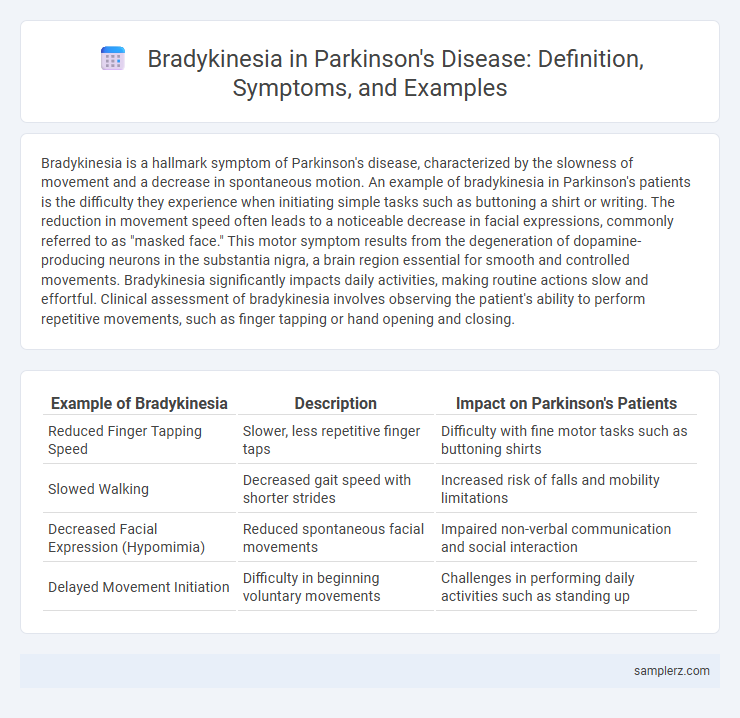Bradykinesia is a hallmark symptom of Parkinson's disease, characterized by the slowness of movement and a decrease in spontaneous motion. An example of bradykinesia in Parkinson's patients is the difficulty they experience when initiating simple tasks such as buttoning a shirt or writing. The reduction in movement speed often leads to a noticeable decrease in facial expressions, commonly referred to as "masked face." This motor symptom results from the degeneration of dopamine-producing neurons in the substantia nigra, a brain region essential for smooth and controlled movements. Bradykinesia significantly impacts daily activities, making routine actions slow and effortful. Clinical assessment of bradykinesia involves observing the patient's ability to perform repetitive movements, such as finger tapping or hand opening and closing.
Table of Comparison
| Example of Bradykinesia | Description | Impact on Parkinson's Patients |
|---|---|---|
| Reduced Finger Tapping Speed | Slower, less repetitive finger taps | Difficulty with fine motor tasks such as buttoning shirts |
| Slowed Walking | Decreased gait speed with shorter strides | Increased risk of falls and mobility limitations |
| Decreased Facial Expression (Hypomimia) | Reduced spontaneous facial movements | Impaired non-verbal communication and social interaction |
| Delayed Movement Initiation | Difficulty in beginning voluntary movements | Challenges in performing daily activities such as standing up |
Understanding Bradykinesia in Parkinson’s Disease
Bradykinesia in Parkinson's disease manifests as a marked slowness in voluntary movements, often observed through reduced facial expression, slow hand movements, and difficulty initiating gait. This motor symptom results from the degeneration of dopamine-producing neurons in the substantia nigra, impairing basal ganglia function crucial for smooth, coordinated motion. Recognizing bradykinesia is essential for diagnosing Parkinson's and tailoring interventions like dopaminergic medications and physical therapy to improve patient mobility and quality of life.
Common Daily Manifestations of Bradykinesia
Bradykinesia in Parkinson's disease commonly manifests as slowed movements during routine activities such as walking, buttoning clothes, and writing. Patients often experience a decreased amplitude and speed of hand movements, leading to smaller, more effortful handwriting known as micrographia. Difficulty initiating movements and a noticeable reduction in facial expressions are frequent signs observed by clinicians and caregivers.
How Bradykinesia Affects Walking and Gait
Bradykinesia in Parkinson's disease causes significant slowness in initiating and executing walking movements, resulting in a shuffling gait and reduced stride length. This motor impairment leads to difficulty in maintaining balance and coordinating the rhythmic pattern of walking, increasing the risk of falls. Patients often experience a decreased arm swing and a stooped posture, further complicating mobility and daily activities.
Examples of Bradykinesia in Fine Motor Skills
Bradykinesia in Parkinson's disease often manifests as a significant slowing or reduction in fine motor skills, such as difficulty buttoning shirts, writing smaller and more slowly (micrographia), and challenges in using utensils during meals. Patients may also experience decreased finger-tapping speed and diminished hand dexterity, impacting daily tasks and overall hand coordination. These symptoms stem from impaired motor planning and execution related to basal ganglia dysfunction.
Impact of Bradykinesia on Facial Expressions
Bradykinesia in Parkinson's disease significantly reduces facial muscle movement, leading to a masked facial expression known as hypomimia. This diminished facial expressiveness impacts social interactions and emotional communication, often causing misunderstandings or social withdrawal. The reduction in spontaneous facial movements is a key clinical feature used to assess the progression of motor symptoms in Parkinson's patients.
Bradykinesia and Slowness in Speech
Bradykinesia, a cardinal symptom of Parkinson's disease, manifests as a marked slowness in voluntary movements, including speech production. Patients often experience hypophonia, characterized by reduced speech volume and monotonous tone, resulting from impaired motor control of vocal muscles. This motor speech deficit reflects the basal ganglia dysfunction underlying bradykinesia and significantly impacts communication ability in Parkinson's patients.
Difficulties with Initiating Movement
Bradykinesia in Parkinson's disease manifests as significant difficulties with initiating movement, such as a delayed start when attempting to walk or perform simple tasks like buttoning a shirt. Patients often experience a noticeable reduction in spontaneous movement, leading to stiffness and slowness that impact daily activities. This impaired motor initiation is a core symptom affecting quality of life and requires targeted therapeutic strategies for management.
Challenges in Rising from a Seated Position
Bradykinesia in Parkinson's disease often manifests as significant difficulty in rising from a seated position, where patients experience slow, hesitant, and effortful movements. This challenge arises from impaired motor planning and muscle rigidity, leading to decreased postural stability and increased risk of falls. Effective management requires targeted physical therapy and assistive devices to improve mobility and safety during transitions.
Effects of Bradykinesia on Routine Activities
Bradykinesia, a hallmark symptom of Parkinson's disease, significantly slows voluntary movements, impairing routine activities such as dressing, eating, and writing. This reduction in movement speed leads to increased difficulty in initiating tasks and maintaining fluidity in actions, often resulting in fatigue and frustration. Motor impairments linked to bradykinesia decrease overall independence, necessitating tailored therapeutic interventions to improve daily function.
Strategies for Managing Bradykinesia in Parkinson’s Patients
Effective strategies for managing bradykinesia in Parkinson's patients include tailored physical therapy programs that emphasize repetitive, rhythmic movements to improve motor function. Pharmacological treatments such as levodopa and dopamine agonists remain central to symptom control by enhancing dopaminergic activity in the brain. Assistive devices and lifestyle modifications, including occupational therapy and regular exercise, contribute to maintaining mobility and reducing the impact of bradykinesia on daily living.

example of bradykinesia in Parkinson Infographic
 samplerz.com
samplerz.com